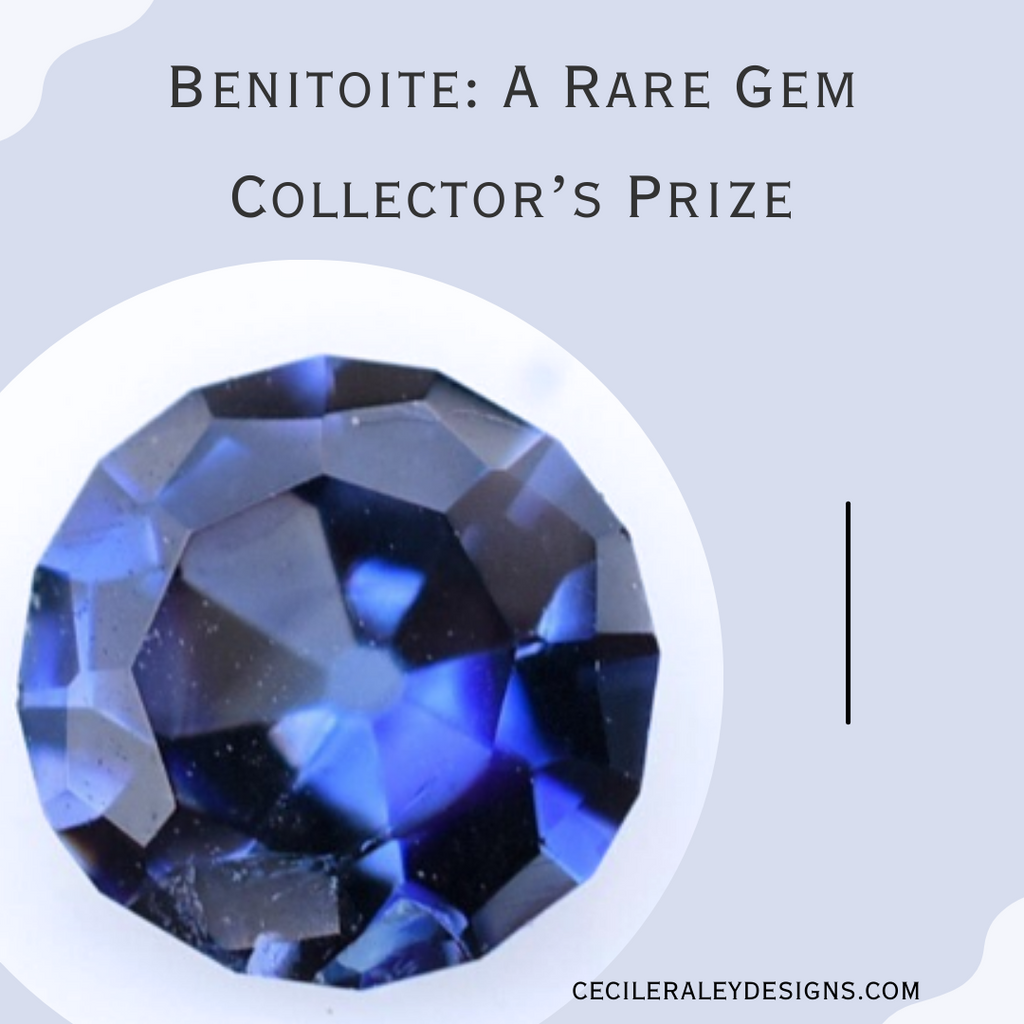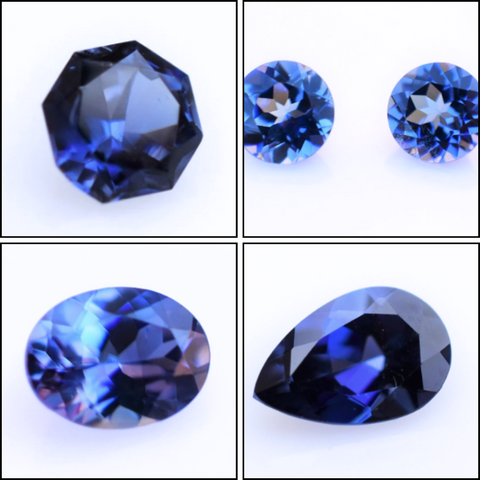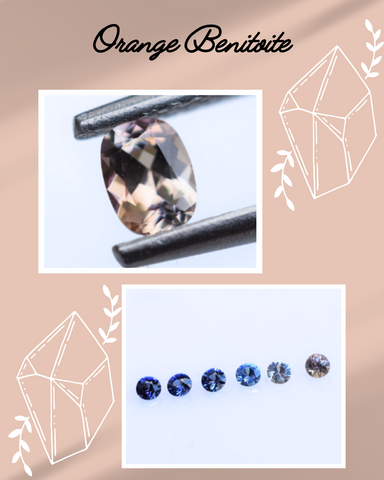Benitoite: A Rare Prize for Gem Collectors

Somewhere about half way between Los Angeles and San Francisco, along the coast of California, you will find the rolling hills of the San Benito Mountains – the origin of the famous and exceptionally rare Benitoite. The mineral whose chemical name is barium titanium cyclosilicate, can also be found in Japan and Arkansas but facet grade material comes only from the San Benito Mountains.
What is the current availability of Benitoite?
First discovered in 1907, only a small piece of the Benitoite mine is currently still in operation - its website even advertises gem hunts and private digs, but the gemmy material has long been mined out. You can find a fairly detailed account of the history of Benitoite here: https://collectorsedge.com/benitoite-gem-mine-san-benito-county-california/
The more valuable available rough has made it into the hands of very few gem sellers, with the lion’s share being owned by a small wholesaler in Ohio. The crystals and loose materials have already all been faceted and sold off but the company still treats pieces in host rock (natrolite) with acid a couple of times a year and then has the resulting gemstone rough faceted by a cutter who specializes in the material. The yield is typically very small at this point, with little to no material above .3 carats in weight.
Because so many collectors are trying to buy the small yield that is sold every year, the owners of the rough do not sell it on the open market. They used to exhibit at the Inn Suites in Tucson but buyers would sleep outside the vendor’s room the night before opening (or camp out starting at 5 a.m.), only to storm the room once they opened and buying out everything within a couple of hours. As that left the regular buyers in the lurch at times, the seller decided this process was unfair to the regulars, some of whom are vendors also and cannot simply leave their booth during showtimes, or sleep on the floor in a hotel hallway. Nor should anyone have to!

I remember one show in Denver where I had a pass for setup day from another person, and I circled the Benitoite booth for hours waiting for them to have pieces out. So did others but the sellers said “tomorrow, not before.” So I used my pass to get in an hour before the official opening the next day and made my purchase then. I never slept in a hotel hallway though! No way.
In 2020, the sellers decided to create a short list of buyers for the amount that they can sell each year and set up private meetings with the buyers instead (this also worked well because of Covid). If I do a search online for Benitoite, I recognize the other names from the list of buyers, most of whom I have run into over the years.
To sell the faceted Benitoite fairly, the current owners divide up the yield from each production as best they can so that each listed buyer gets a small number of gems based on their preferences. Buyers can accept their entire lot or reject some or all of it. Prices are fixed but fair. By the end of the 2-3 days of private appointments, all the Benitoite is sold. Leftovers from previous buyers are either saved for the last day or shown to the next buyer. Then we have to wait for the next show date. A week before we get an email with the details of where they will be and an appointment time. This information is kept private for each buyer.
What makes Benitoite so special?
Visually, Benitoite looks almost exactly like sapphire, and in those tiny sizes, sapphire is much cheaper. So if you just want to have a rich blue gemstone, you do not need Benitoite. The gem is popular among collectors because of its single origin. It is especially popular among Japanese buyers, perhaps because Japan is a place of origin for non-gemmy Benitoite.

The Benitoite above (.13cts, 3.54 x 2.24 x 1.45mm) is available here in the shop.
Benitoite also fluoresces strongly, so it can be distinguished from sapphire under UV light where Benitoite turns into a bright neon blue and sapphire doesn’t. The natural color of Benitoite ranges from blue to white and there is no known treatment that improves either clarity or the blue color, so you will mostly buy it in its original state.
What is orange Benitoite?
Orange Benitoite is prized among collectors and when we carry suites that include orange they usually sell on the first day. I am personally not sure what makes them popular however.

To get orange Benitoite, you need a very clean specimen of clear Benitoite that is then heat treated. The reason the material has to be clean is that high heat will open up fissures and crack the stone. This is a problem for heating any gems, in particular those with a lower hardness such as aquamarine and tourmaline. Both have the tendency to crack.
Since even clear (or white) Benitoite sells very well as is, sellers don’t really see a need to create orange Benitoite from it, especially given the added risk. That’s an additional reason you rarely see it on the market. Less than half a dozen people in the world know how to correctly heat a Benitoite to get the coveted orange color. So this is nothing for you to try at home!
And what about cost?
If you are reading this blog then you already know that Benitoite is quite expensive. Above 1 carat Benitoite is in excess of 10K per carat wholesale, and larger pieces are anybody’s guess. It’s a total seller’s market and anyone who has it can name their asking price. If you want to buy and you don’t want to pay the asking price, you simply won’t end up owning any. Even non gemmy and ugly pieces can end up being very overpriced if they are a little bigger. Most people who own these larger pieces are not fussed at all about selling them. They know they can only do so once and then the opportunity does not come back, which means there’s little reason to allow bargaining or sell at a discount.
At CRD, we mainly offer smaller, cleaner and gem grade material that we feel is worth having and still affordable. We can also source larger pieces for you as we are aware of a few sellers who have materials between .5 and 2 carats and are happy to buy it for you. But please note that you cannot bargain for lower prices or payment plans or any other special treatment. If I go to a vendor with those requests, I will just be ignored. Just as with the top grade Paraiba and other valuable gems, there’s so little around and those who are desperate for cash already sold out of the good stuff years ago. The main thing we can do for you is offer to source it in the first place, but it isn’t going to be a “Bargain Basement” kind of deal.
Does Benitoite need to be certified?
Technically you do not need a cert for Benitoite. All you need is to make sure it isn’t sapphire (or something else, i.e. a blue spinel). For that, a simple gem ID will be more than sufficient. As mentioned above, there is no known treatment for Benitoite, so you don’t need to have it tested for heat. And since it has a single origin only, it also doesn’t make sense to ask for that. From that point of view, therefore, Benitoite is a safe buy!
